Driving Force Analysis of the Temporal and Spatial Distribution of Flash Floods in Sichuan Province
Abstract
:1. Introduction
2. Study Area
3. Data and Methods
3.1. Data
- (1)
- The flash flood data for Sichuan Province from 1949 to 2014 were derived from the FFIEDC, and these data include the location, time, and number of casualties.
- (2)
- Small watershed (10 to 50 km2) data are from the FFIEDC.
- (3)
- A digital elevation model (DEM) was obtained from the Bureau of Surveying and Cartography (SBSC). The DEM included elevation and slope.
- (4)
- Soil type data were provided by the RESDC. The soil types included silt, sandy loam, sandy clay, loam, clay, and rock.
- (5)
- Daily precipitation data from the meteorological stations in Sichuan Province and the surrounding areas were obtained from the National Weather Service of China.
- (6)
- The GDPs for 1 km × 1 km grid population data were obtained from the RESDC. These spatially distributed data were transformed from census data based on a specialized model.
- (7)
- The fractional coverage of vegetation was calculated from the 1 km × 1 km grid MOD13A2 of NASA, as shown in Equation (2).
3.2. Methodology
3.2.1. Factor Acquisitions
3.2.2. Geographical Detector-Based Assessment
4. Results and Discussion
4.1. Temporal and Spatial Distribution of Flash Floods
4.2. Factor Distributions
4.2.1. Environmental Background Conditions
4.2.2. Precipitation
4.2.3. Human Activity
4.3. Risk Factors for the Spatial Distribution of Flash Floods
4.4. Driving Forces of Temporal and Spatial Variability
5. Conclusions
Acknowledgments
Author Contributions
Conflicts of Interest
References
- Zhang, Z. Characters of flash floods in China and prevention methods. China Water Resour. 2007, 14, 14–15. [Google Scholar]
- Yuan, X.; Liu, Y.; Huang, Y.; Tian, F. An approach to quality validation of large-scale data from the Chinese Flash Flood Survey and Evaluation (CFFSE). Nat. Hazards 2017, 2, 1–12. [Google Scholar] [CrossRef]
- Cui, P.; Zou, Q. Theory and method of risk assessment and risk management of debris flows and flash floods. Prog. Geogr. 2016, 35, 137–147. [Google Scholar] [CrossRef]
- Bajabaa, S.; Masoud, M.; Al-Amri, N. Flash flood hazard mapping based on quantitative hydrology, geomorphology and GIS techniques (case study of Wadi Al Lith, Saudi Arabia). Arab. J. Geosci. 2014, 7, 2469–2481. [Google Scholar] [CrossRef]
- Shi, P.; Lv, L.; Wang, M.; Wang, J.A.; Chen, W.F. Disaster system: Disaster cluster, disaster chain and disaster compound. J. Nat. Dis. 2014, 23, 1–12. [Google Scholar]
- Zhong, D.; Xie, H.; Wei, F. Discussion on mountain hazards chain. J. Mt. Sci. 2013, 31, 314–326. [Google Scholar]
- Chuan, T.; Jing, Z. A GIS based regional torrent risk zonation. Acta Geogr. Sinica 2005, 60, 87–94. [Google Scholar]
- Du, J.; Ren, H.; Zhang, P.; Zhang, C. Comparative study of the hazard assessment of mountain torrent disasters in macro scale. J. Catastrophol. 2016, 31, 66–72. [Google Scholar]
- Guihua, L.; Ling, Z.; Zhiyong, W.; Hai, H. Zoning of mountain torrent hazards in medium-small river basions. Earth Sci. J. China Univ. Geosci. 2014, 39, 1438–1444. [Google Scholar]
- Zhao, G.; Pang, B.; Xu, Z.; Wang, Z.; Shi, R. Assessment on the hazard of flash flood disasters in China. J. Hydraul. Eng. 2016, 47, 1133–1142. [Google Scholar]
- Terti, G.; Ruin, I.; Anquetin, S.; Gourley, J.J. Dynamic vulnerability factors for impact-based flash flood prediction. Nat. Hazards 2015, 79, 1481–1497. [Google Scholar] [CrossRef]
- Rodgers, W.N. Land Cover Change and Its Impacts on a Flash Flood-Producing Rain Event in Eastern Kentucky. Master’s Thesis, Western Kentucky University, Bowling Green, KY, USA, 2014. [Google Scholar]
- Huang, G.; Chen, Z. Research on critical rainfall of mountain torrent disasters based on effective antecedent rainfall. J. Nat. Dis. 2014, 23, 192–197. [Google Scholar]
- Tao, Y.; Tang, C. Influence of human activity and precipitation change on middle-long term evolution of landslide and debris flow disasters. Plateau Meteorol. 2012, 31, 1454–1460. [Google Scholar]
- Blöschl, G.; Ardoin-Bardin, S.; Bonell, M.; Dorninger, M.; Goodrich, D.; Gutknecht, D.; Matamoros, D.; Merz, B.; Shand, P.; Szolgay, J. At what scales do climate variability and land cover change impact on flooding and low flows? Hydrol. Process. 2007, 21, 1241–1247. [Google Scholar] [CrossRef]
- Zhao, S. A Preliminary Study on the Spatial and Temporal Scales of Natural Disaster Risk Analysis. J. Catastrophol. 2012, 27, 1–6. [Google Scholar]
- Pollak, D.A. Flash Floods: A Spatial and Temporal Analysis A Case Study of the Flash Floods in Southwestern Missouri. In Proceedings of the AGU Fall Meeting, San Francisco, CA, USA, 14–18 December 2009. [Google Scholar]
- Chen, G.; Xie, P.; Xiong, L. Spatial and Temporal Prediction of Flash Floods in Ungauged Area Based on GIS. In Advances in Water Resources and Hydraulic Engineering; Springer: Berlin/Heidelberg, Germany, 2009; pp. 1219–1227. [Google Scholar]
- Tramblay, Y.; Bouvier, C.; Crespy, A.; Arthur, M. Improvement of flash flood modelling using spatial patterns of precipitation: A case study in southern France. Ecology 2010, 92, 1936–1947. [Google Scholar]
- Vennari, C.; Parise, M.; Santangelo, N.; Santo, A. A database on flash flood events in Campania, southern Italy, with an evaluation of their spatial and temporal distribution. Nat. Hazards Earth Syst. 2016, 16, 2485–2500. [Google Scholar] [CrossRef]
- Cui, P. Progress and prospects in research on mountain hazards in China. Prog. Geogr. 2014, 33, 145–152. [Google Scholar]
- Billi, P.; Alemu, Y.T.; Ciampalini, R. Increased frequency of flash floods in Dire Dawa, Ethiopia: Change in precipitation intensity or human impact? Nat. Hazards 2015, 76, 1373–1394. [Google Scholar] [CrossRef]
- Fan, J.; Zhang, Z.; Li, L. Mountain demarcation and mountainous area divisions of Sichuan Province. Goegr. Res. 2015, 34, 65–73. [Google Scholar]
- National flood prevention and Control Project Group. The Report for National Flash Flood Investigation and Evaluation Project; National Flash Flood Disaster Project Group: Beijing, China, 2016. [Google Scholar]
- Guo, L.; Liu, C.J.; Ding, L.Q.; Sun, D.Y. Working plan for mountain flood investigation and evaluation in China. China Water Resour. 2012, 23, 10–12. [Google Scholar]
- Huang, X.L.; Chu, M.H.; Shi, J.S. Analysis on flash flood investigation and assessment in China. China Water Resour. 2015, 9, 17–18. [Google Scholar]
- Sun, D.; Zhang, D.; Cheng, X. Framework of national non-structural measures for flash flood disaster prevention in China. Water 2012, 4, 272–282. [Google Scholar] [CrossRef]
- Ord, J.K.; Getis, A. Local Spatial Autocorrelation Statistics: Distributional Issues and an Application. Geogr. Anal. 1995, 27, 286–306. [Google Scholar] [CrossRef]
- Li, H.W.; Wang, Q. Study on precipitation index selection for hazard analysis of mountain torrents disaster of small watersheds. J. Geo-Inf. Sci. 2017, 19, 425–435. [Google Scholar]
- Michael, F.H.; Xu, T.B. Anusplin Version 4.4 User Guide; The Australian National University, Fenner School of Environment and Society: Canberra, Australia, 2013. [Google Scholar]
- Quarmby, N.A.; Townshend, J.R.G.; Settle, J.J.; White, K.H.; Milnes, M.; Hindle, T.L.; Silleos, N. Linear mixture modelling applied to AVHRR data for crop area estimation. Int. J. Remote Sens. 1992, 13, 415–425. [Google Scholar] [CrossRef]
- Wang, J.F.; Li, X.H.; Christakos, G.; Liao, Y.L.; Zhang, T.; Gu, X.; Zheng, X.Y. Geographical detectors-based health risk assessment and its application in the neural tube defects study of the Heshun region, China. Int. J. Geogr. Inf. Sci. 2010, 24, 107–127. [Google Scholar] [CrossRef]
- Wang, J.F.; Zhang, T.L.; Fu, B.J. A measure of spatial stratified heterogeneity. Ecol. Indic. 2016, 67, 250–256. [Google Scholar] [CrossRef]
- Qiao, L.; Li, Y.X.; Fu, J.L. Grade of Precipitation, GB/T 28592–2012; Standards Press of China: Beijing, China, 2012. [Google Scholar]
- Guo, T.F. Comprehensive Control of Soil and Water Conservation-General Rule of Planning, GB/T 15772–2008; Standards Press of China: Beijing, China, 2009. [Google Scholar]
- Institute of Geography, Chinese Academy of Science (Ed.) 1:100000000 Geomorphological Mapping Specification (Trial); Science Press: Beijing, China, 1987; pp. 1–44. [Google Scholar]
- Liu, Y.; Yang, R. The spatial characteristics and formation mechanism of the county urbanization in China. Acta Geogr. Sinica 2012, 67, 1011–1020. [Google Scholar]
- Li, J.; Lu, D.; Xu, C.; Li, Y.; Chen, M. Spatial heterogeneity and its changes of population on the two sides of Hu Line. Acta Geogr. Sinica 2017, 1, 148–160. [Google Scholar]
- Du, J.; Ding, W.F.; Ren, H. Relationships between different types of flash flood disasters and their main impact factors in the Sichuan Province. Resour. Environ. Yangtzw Basin 2015, 24, 1977–1983. [Google Scholar]
- Cui, Y.; Kong, J.; Tian, S. The critical role for heavy rainfall in the evolution of the mountain hazards chains. J. Mt. Sci. 2011, 29, 87–94. [Google Scholar]
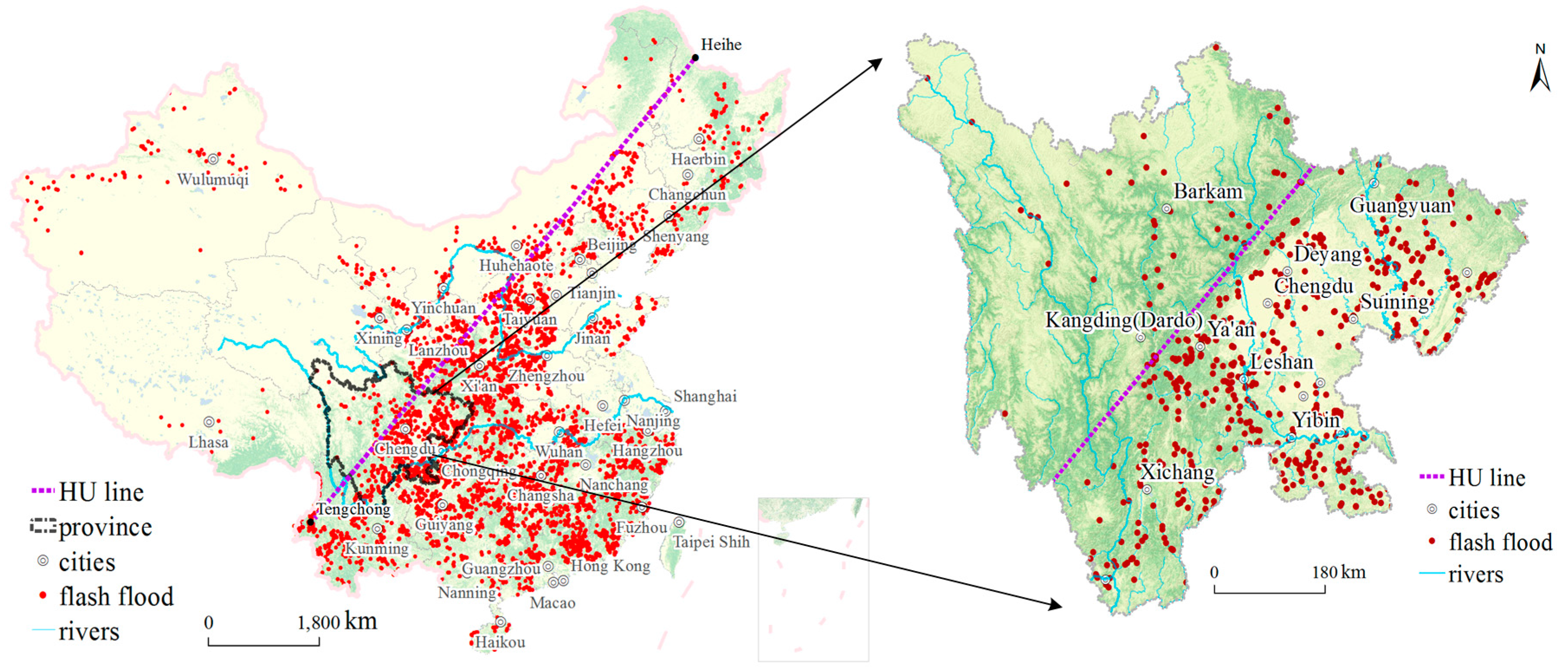
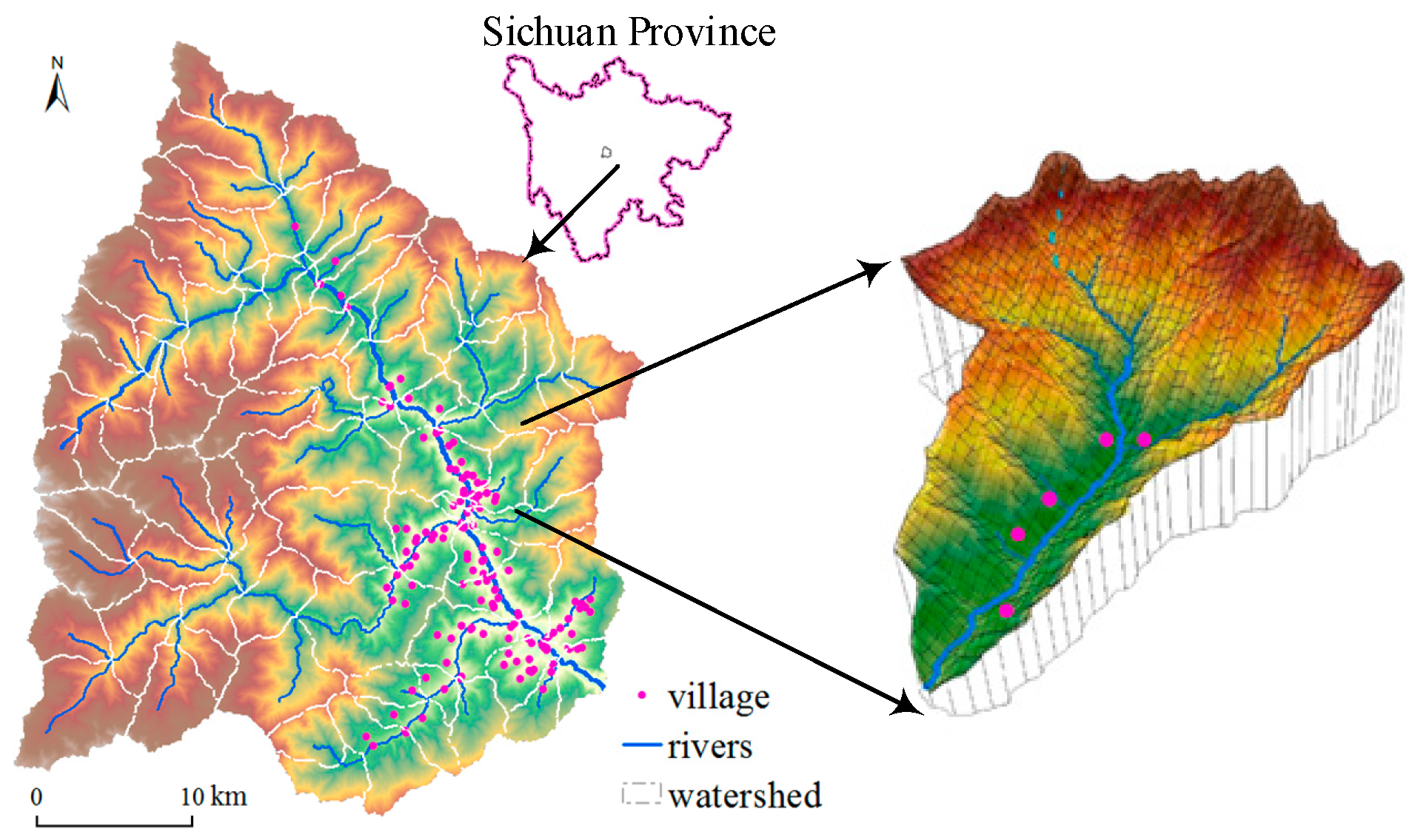
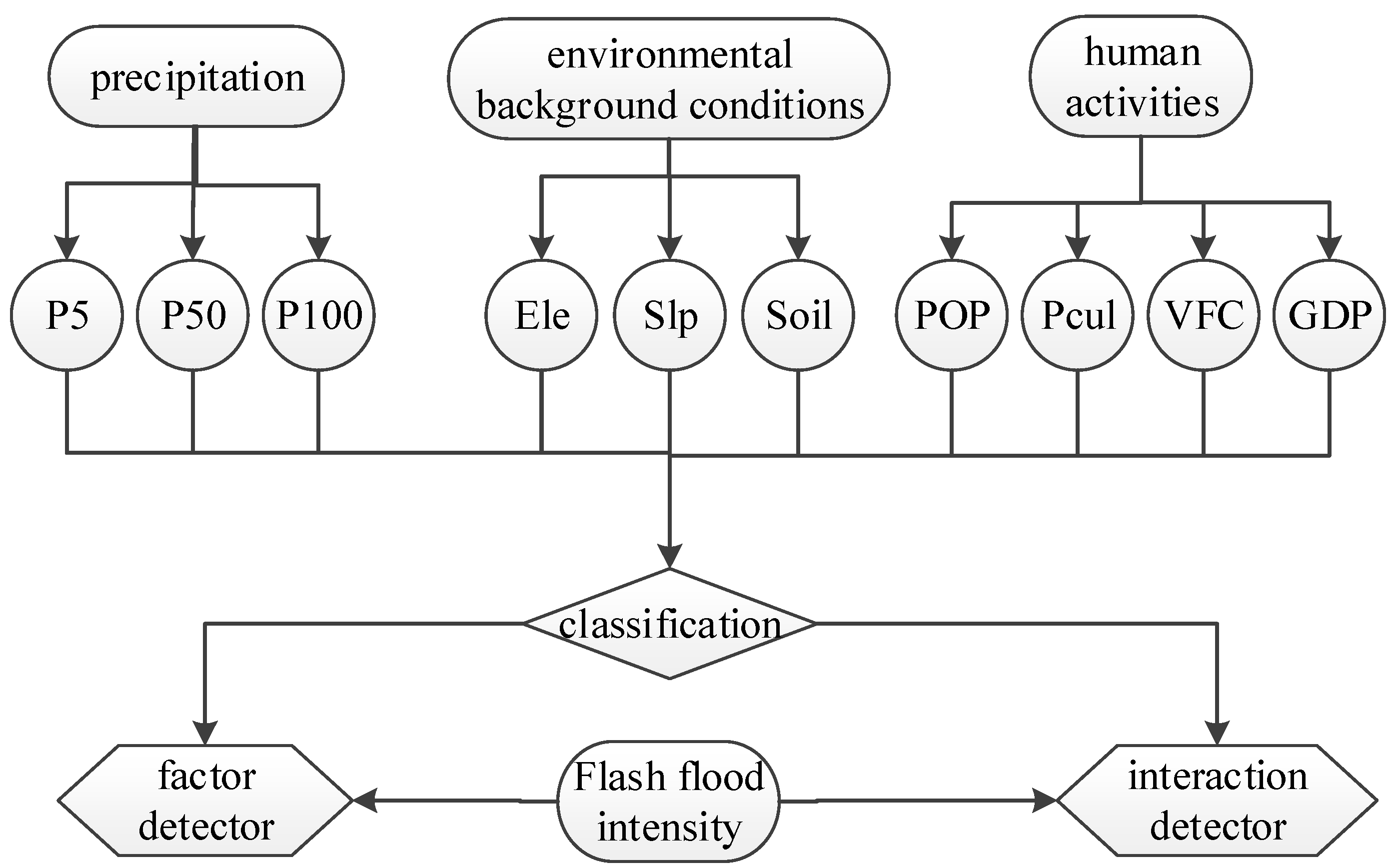



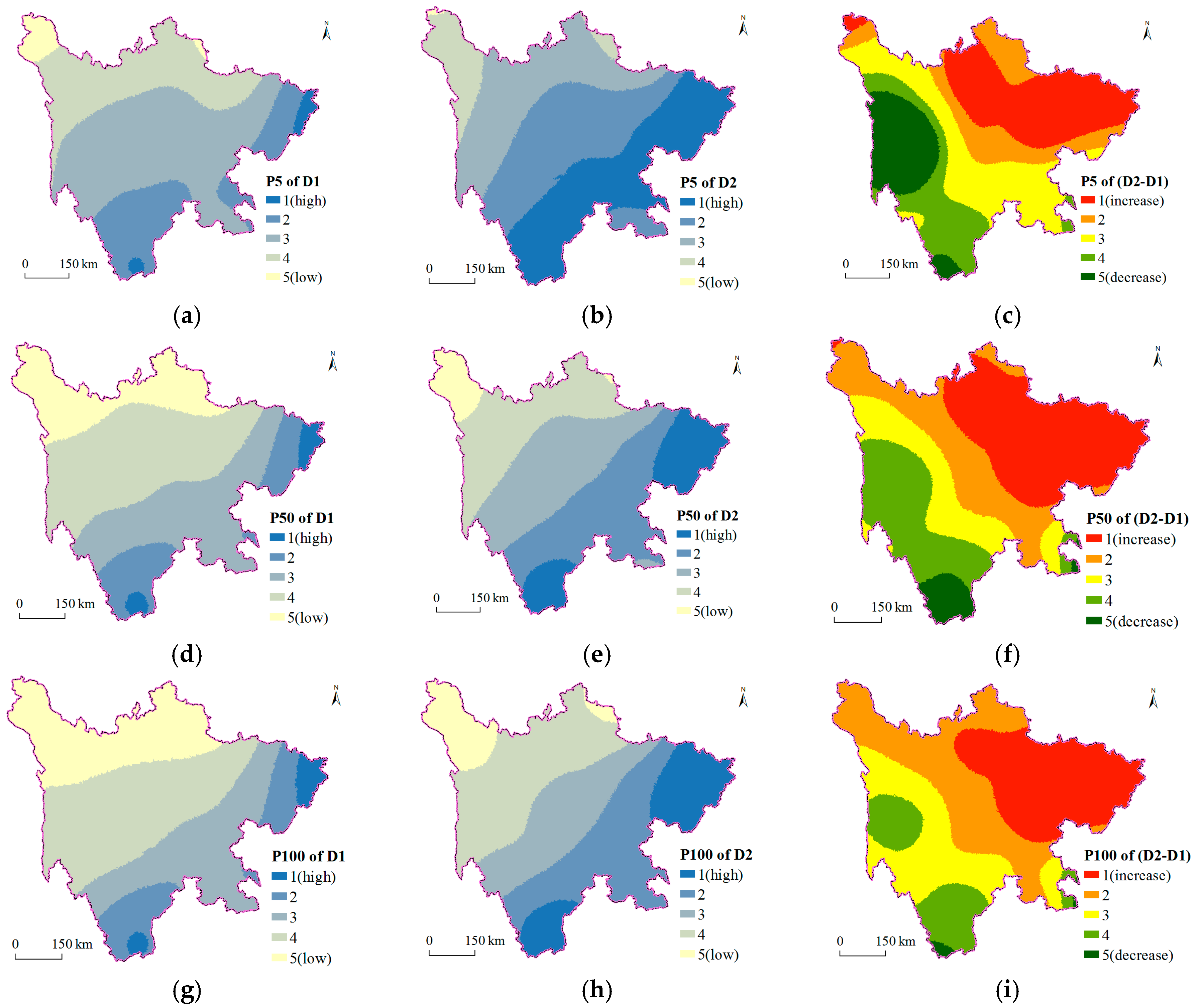
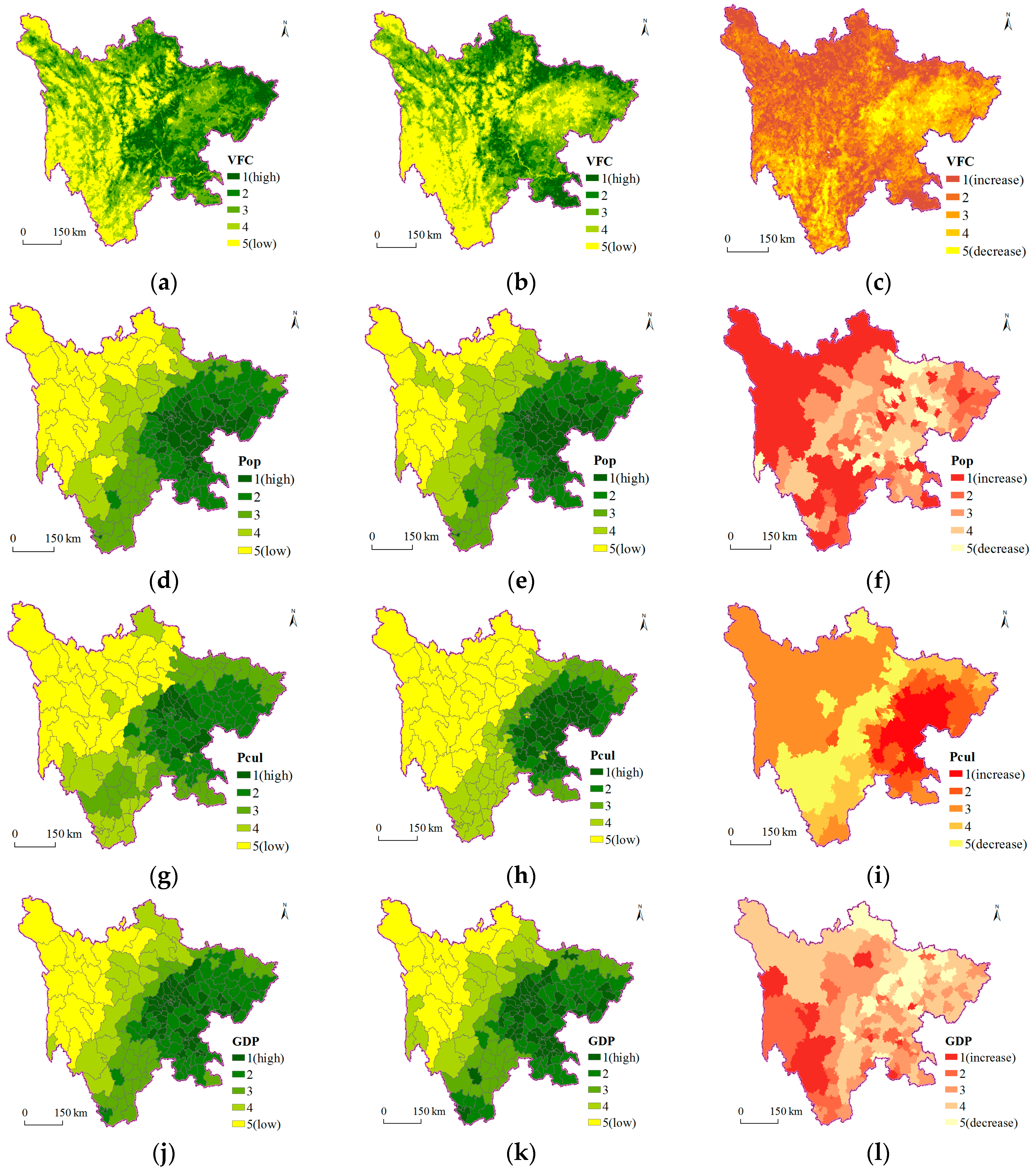
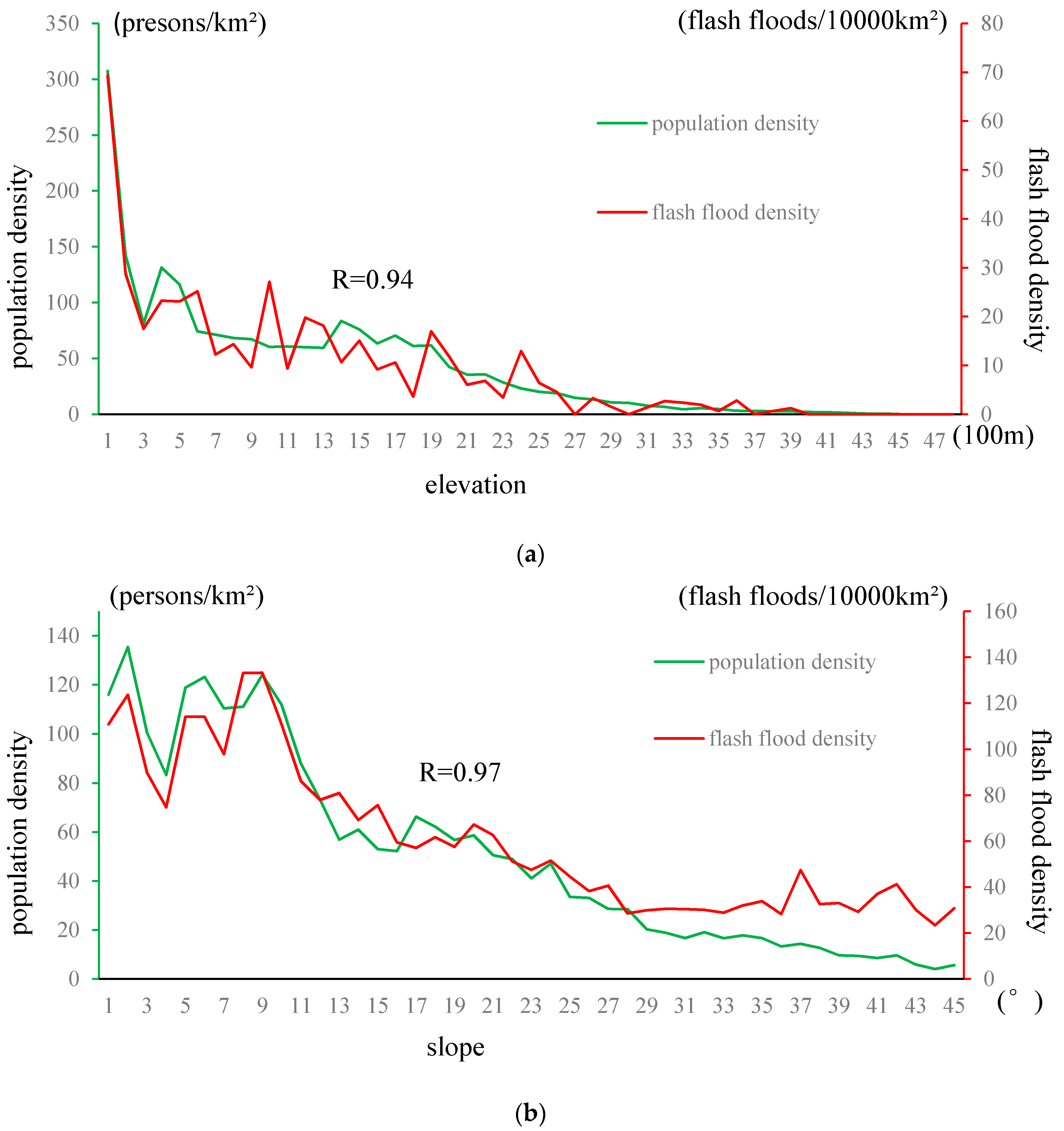
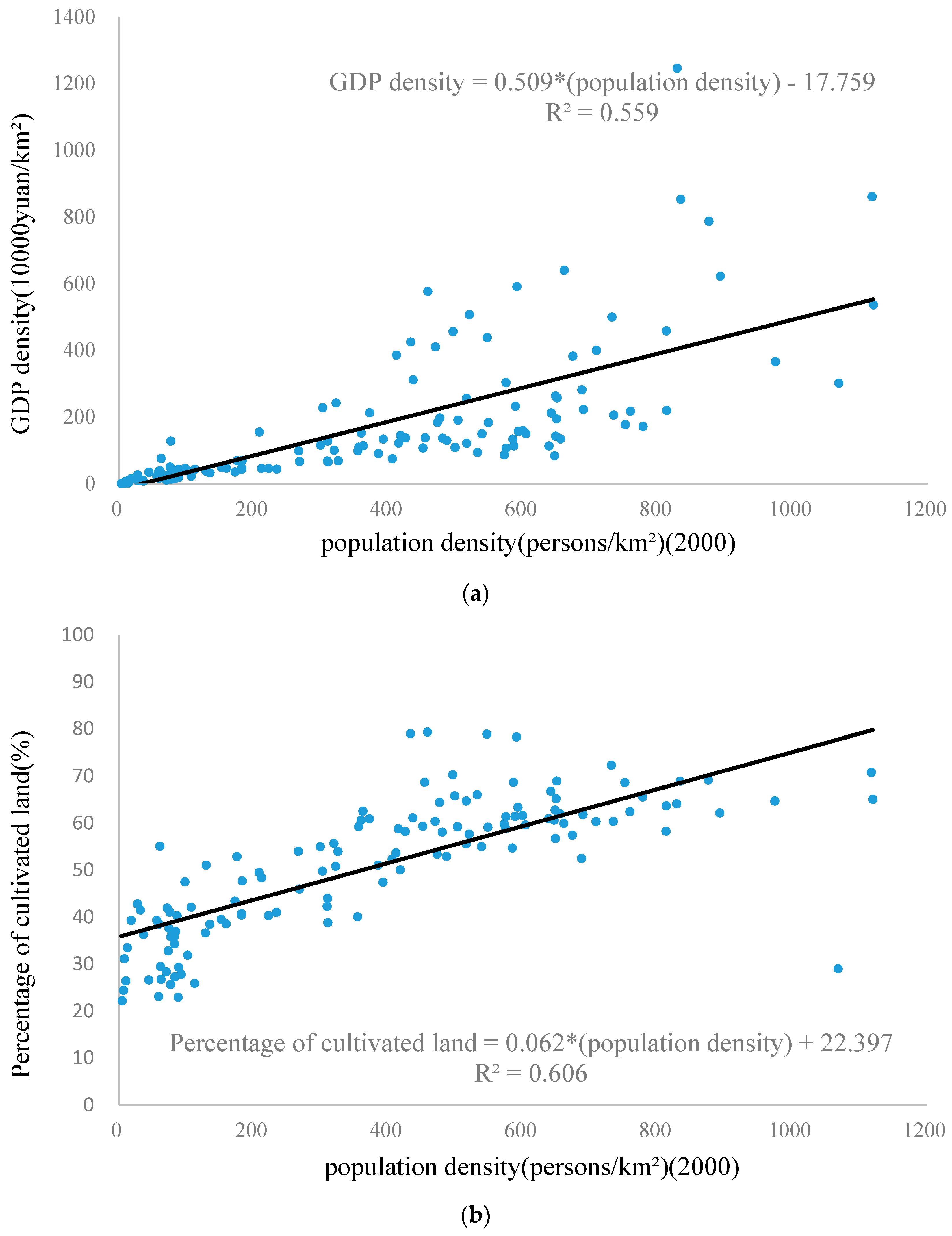

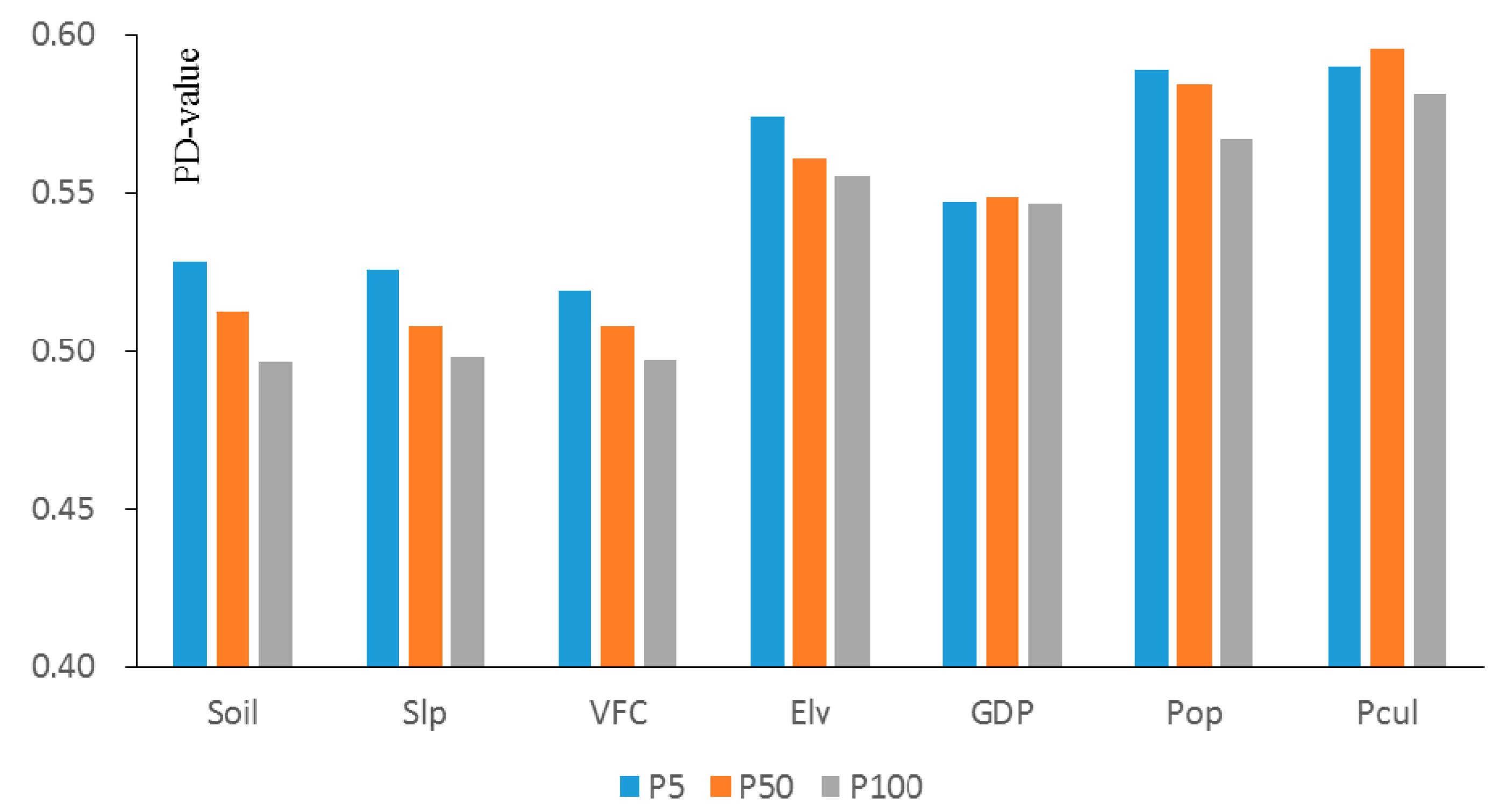
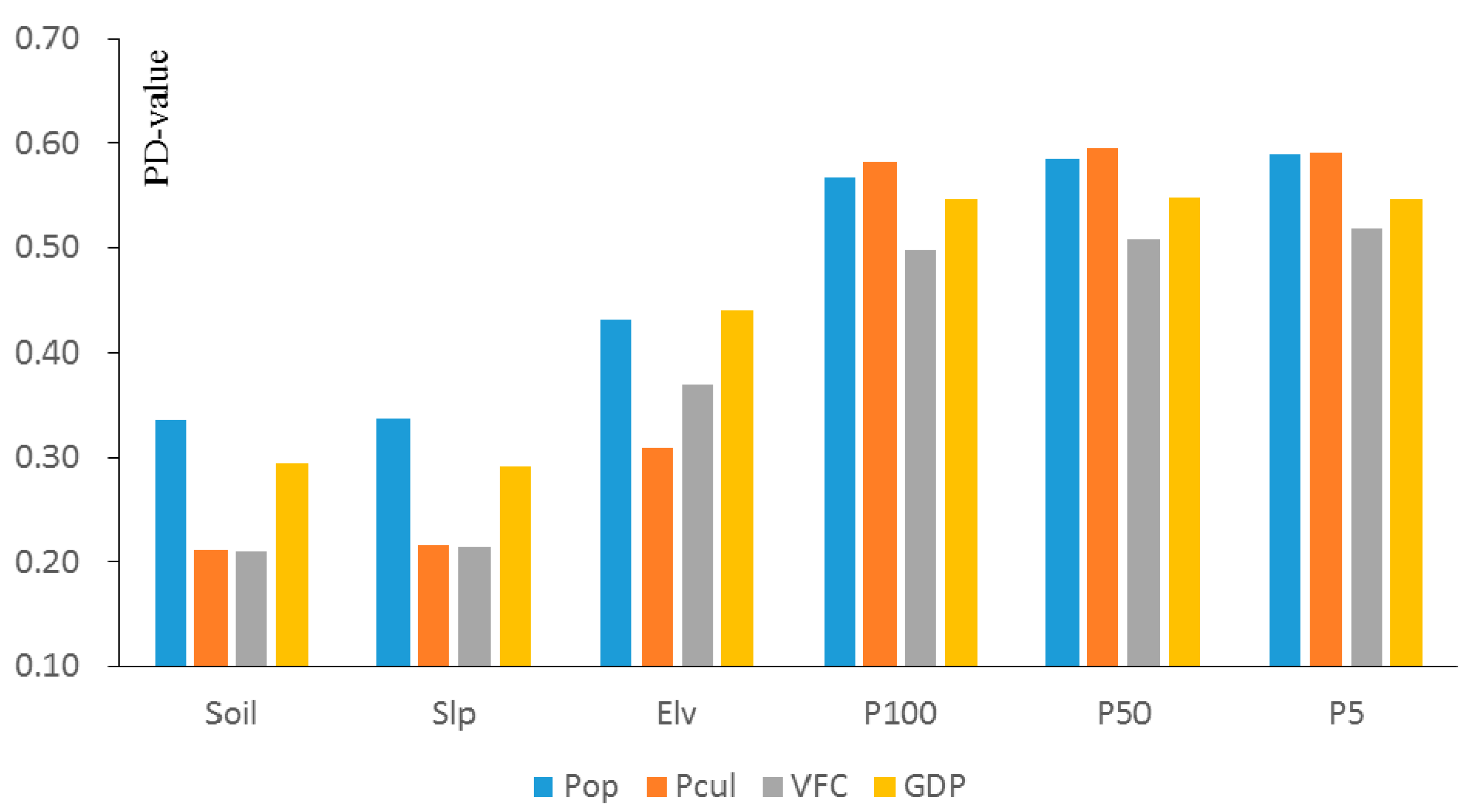
| Factors | Parameters | Scale or Resolution | Time | Data Sources |
|---|---|---|---|---|
| Flash floods | flash floods | 1:50,000 | 1949–2014 | Flash Flood Investigation and Evaluation Dataset of China (FFIEDC) |
| small watershed | 1:50,000 | 2014 | FFIEDC | |
| Environmental background conditions | elevation | 1:50,000 | 2014 | SBSC |
| slope | 1:50,000 | 2014 | SBSC | |
| soil type | 1:100,000 | 2014 | RESDC * | |
| Precipitation | daily precipitation | - | 1995–2014 | CMA |
| Human activities | population density | 1 km × 1 km | 2000, 2010 | RESDC * |
| farm land | 1 km × 1 km | 2000, 2010 | RESDC * | |
| vegetation fractional coverage of vegetation | 1 km × 1 km | 2000, 2010 | NASA, MODIS | |
| GDP density | 1 km × 1 km | 2000, 2010 | RESDC * |
| Type | Factor Name | Description |
|---|---|---|
| Flash flood intensity | F(95-04) | Disaster intensity index of a small watershed from 1995 to 2004 |
| F(05-14) | Disaster intensity index of a small watershed from 2005 to 2014 | |
| Environmental background conditions | Ele | Average elevation of a small watershed (m) |
| Slp | Average slope of a small watershed (°) | |
| Soil | Soil type that accounts for the largest proportion of the total area in a small watershed | |
| Precipitation | P5 | Index of days with daily precipitation greater than 5 mm |
| P50 | Index of days with daily precipitation greater than 50 mm | |
| P100 | Index of days with daily precipitation greater than 100 mm | |
| Human activities | POP | Population density (persons/km2) |
| Pcul | Percentage of the total area of cultivated land (%) | |
| VFC | fractional coverage of vegetation (calculated from NDVI(Normalized Difference Vegetation Index) data) | |
| GDP | GDP density (10,000 yuan/km2) |
| Environmental Background Conditions | Precipitation | Human Activities | ||||||||
|---|---|---|---|---|---|---|---|---|---|---|
| PD value | Ele | Soil | Slp | P5 | P50 | P100 | POP | Pcul | VFC | GDP |
| D95–04 | 0.593 | 0.156 | 0.169 | 0.465 | 0.699 | 0.771 | 0.646 | 0.565 | 0.077 | 0.614 |
| D05–14 | 0.734 | 0.197 | 0.191 | 0.582 | 0.673 | 0.711 | 0.776 | 0.670 | 0.098 | 0.729 |
| D05–14–D95–04 | 0.218 | 0.071 | 0.096 | 0.483 | 0.453 | 0.441 | 0.274 | 0.163 | 0.112 | 0.293 |
| Ele | Soil | Slp | P5 | P50 | P100 | POP | Pcul | VFC | GDP | |
|---|---|---|---|---|---|---|---|---|---|---|
| Ele | 0.218 | |||||||||
| Soil | 0.274 | 0.071 | ||||||||
| Slp | 0.306 | 0.173 | 0.096 | |||||||
| P5 | 0.574 | 0.528 | 0.526 | 0.483 | ||||||
| P50 | 0.561 | 0.513 | 0.508 | 0.545 | 0.453 | |||||
| P100 | 0.555 | 0.496 | 0.498 | 0.535 | 0.476 | 0.441 | ||||
| POP | 0.432 | 0.336 | 0.337 | 0.589 | 0.584 | 0.567 | 0.274 | |||
| Pcul | 0.310 | 0.212 | 0.216 | 0.590 | 0.596 | 0.581 | 0.427 | 0.163 | ||
| VFC | 0.370 | 0.211 | 0.215 | 0.519 | 0.508 | 0.497 | 0.391 | 0.302 | 0.112 | |
| GDP | 0.440 | 0.294 | 0.291 | 0.547 | 0.549 | 0.546 | 0.418 | 0.451 | 0.504 | 0.201 |
© 2017 by the authors. Licensee MDPI, Basel, Switzerland. This article is an open access article distributed under the terms and conditions of the Creative Commons Attribution (CC BY) license (http://creativecommons.org/licenses/by/4.0/).
Share and Cite
Liu, Y.; Yuan, X.; Guo, L.; Huang, Y.; Zhang, X. Driving Force Analysis of the Temporal and Spatial Distribution of Flash Floods in Sichuan Province. Sustainability 2017, 9, 1527. https://doi.org/10.3390/su9091527
Liu Y, Yuan X, Guo L, Huang Y, Zhang X. Driving Force Analysis of the Temporal and Spatial Distribution of Flash Floods in Sichuan Province. Sustainability. 2017; 9(9):1527. https://doi.org/10.3390/su9091527
Chicago/Turabian StyleLiu, Yesen, Ximin Yuan, Liang Guo, Yaohuan Huang, and Xiaolei Zhang. 2017. "Driving Force Analysis of the Temporal and Spatial Distribution of Flash Floods in Sichuan Province" Sustainability 9, no. 9: 1527. https://doi.org/10.3390/su9091527





